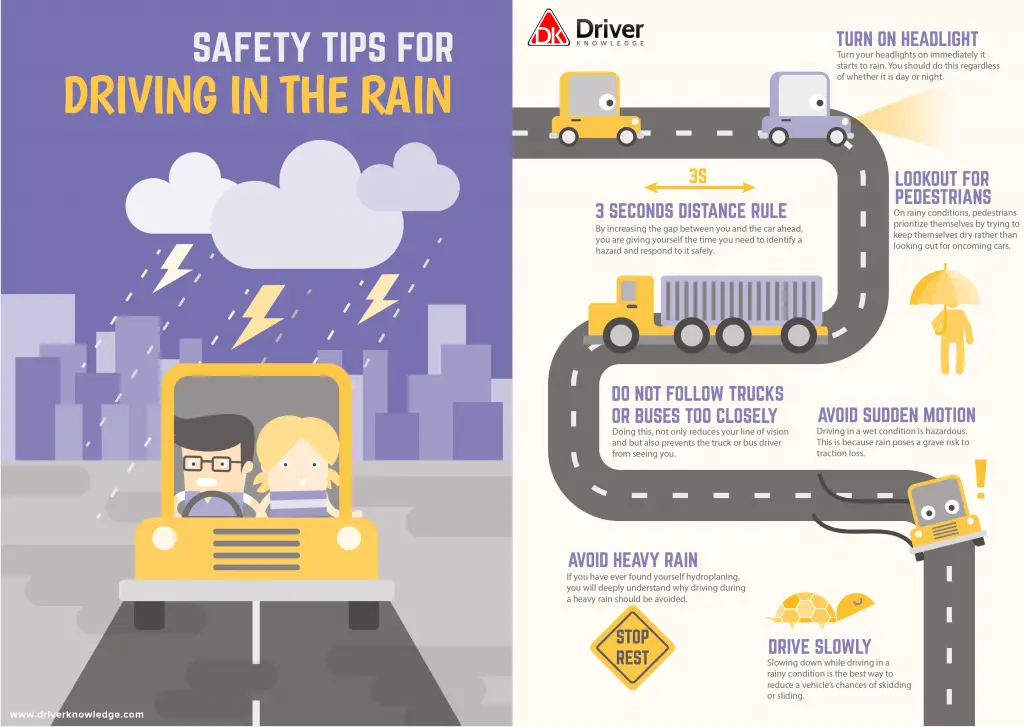Can You Take The Drivers Test In The Rain


Simply put, rain makes everything slippery, and puddles that form can lead to hydroplaning. Apart from what the precipitation does to the road and your car, the rain makes it difficult to see. We've all been there: you're driving along and all of a sudden the downpour becomes so thick that it's hard to see where you're going.
The simple rules to remember that can make your journey easier and safer when driving in the wet With, the prospect of driving in heavy rain is rearing its head once again for many in Britain. For many, it's a daunting task, and no wonder – rain not only reduces visibility, but also the amount of grip your car has, increasing stopping distances. But drive along a motorway in heavy weather, and it’s clear that for others, the opposite is true; many of Britain’s motorists are so over-confident in rain that they barely modify their driving style to suit, if at all. That's why we’ve put together a guide to driving safely in wet weather.
If you find rain scary when you’re on the road, then following these key pointers will help you stay safe. And even if you’re confident in the rain, have a read through, and check you’re driving as safely as you could be. Drive only if it’s necessary Yes, you’ve heard it on the weather forecast all the time, but people say it for a reason.
Hi, everyone. My driving test is this week and it could very well be raining on the day I take it (The test is in California by the way). Are not in alignment with the rules. If you see any questions or comments which break the rules, please use the Report button to help the moderators get to it faster. Use our free Texas drivers license practice test to determine if you are ready for the DPS written test. Learn how you can take the DPS test online.
Put simply, if you don’t go out, you can’t come to any harm on the road. Easyc V4 For Cortex Crack on this page. Is your journey really that urgent or important? If not, it might be better to stay in, have a cup of tea, and wait until the rain passes. That sounds to us like an infinitely better idea than getting stuck in a queue or, worse, at the side of the road with a crashed or broken-down car as the heavens open. Using your lights correctly when the roads are wet will ensure you can see and be seen Check your headlights – and then use them If you do decide to venture out, then before you leave, you should try and make a quick check of your lights.
Turn on your dipped beams, and check the lights are working on both sides, at the front and at the back. When the rain does start to fall, you should turn your headlights on. Don’t just assume they already are – many cars’ instruments light up even when the headlights are turned off these days, which can be misleading. Rather than relying on the lights on your instrumentation, you should check the position of your headlamp switch and make sure it is set to the dipped beam setting. This will improve your vision, and enable other drivers to see you in good time. Winning Eleven 2002 Ps1 Iso Inglesina. If you have automatic headlamps, make sure these have activated – or if you can't, override them manually by turning the headlamp switch to the dipped beam setting. Pick the correct lights Remember, you mustn’t use your fog lamps unless the visibility is very poor – rear fog lamps will dazzle other road users, and the effect is intensified when there is spray coming out from the rear of the car.
Front fog lamps have the same effect, but for cars ahead of you. The Highway Code says that you should only use your fog lamps when the visibility drops below 100m. A good rule of thumb is to think about whether you can see the tail lights of the car in front of you. If you can’t, and you know it isn't that far away, you (and they) should probably be using rear fog lamps. However, if you can, you probably don’t need them.
Wwe Smackdown Vs Raw 2010 Pc Game Setup Free Download. Rain does not mean you need to use your main beam headlamps any more or less often than you would normally. You shouldn’t leave them on when you are driving towards or behind other traffic, as it will dazzle those drivers. If you’re in any doubt about which lights to use, put yourself in the position of other drivers around you. Ask yourself what your car looks like to them, whether they can see you, and whether they might be blinded by any of your lights.
It sounds obvious, but slowing down in wet weather is something many drivers forget to do Adjust your driving style Cast your mind back to your driving test, and you’ll remember that stopping distances increase in the wet. But can you remember by how much? In actual fact, it takes about twice as long to stop on a wet road as it does on a dry one. So you should increase the distance between you and the car you’re following by about that much. A good rule of thumb is that you should be around four seconds behind the car in front of you if the road is wet. That way, if that car has to stop suddenly – or worse still, crashes into a car in front – you will have time to stop, or take avoiding action.